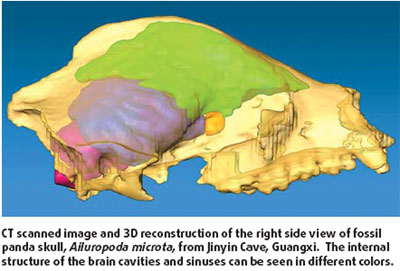Survival of the fattest
Black-and-white giant pandas, China's national treasures, have long enchanted the world with their lovely image of munching on bamboo. But, was this animal the same charming creature some 2 million years ago? Scientists have now proven it was a committed bamboo-eater - but of a much smaller size and with a longer face.
A giant panda in bamboo forest habitat. |
An international research team today reported the first discovery of a fossil skull of the earliest giant panda in South China's Guangxi Zhuang Autonomous Region. Their results are published online in this week's US-journal, Proceedings of the National Academy of Sciences.
The six fossil pieces, unearthed in 2001 in Jinyin Cave, consist of isolated teeth, mandibles and a few rare skulls from the late Pliocene (about 1.8-2.6 million years ago) to late Pleistocene (around 50,000 years ago). Analyses of them indicate Ailuropoda microta, the ancestor of today's giant panda, occupied South China at least 2-2.4 million years ago after a marked global climate deterioration, says the report, by a team of Chinese and US scientists.
The paper's lead author Jin Changzhu, of the Chinese Academy of Sciences (CAS), said the skulls unearthed were much smaller than those of living giant pandas, suggesting the ancestors were at least one third smaller than their descendants.
"In dental remains, we found similar features to giant pandas today that imply a diet of bamboo," says Professor Jin, a paleontologist with CAS' Institute of Vertebrate Paleontology and Paleonanthropology.
The researchers found some smaller cusps between bigger ones on the fossil teeth, which is always related to crushing dentition favoring a reliance on bamboo.
Paleoanthropologist Russell Ciochon, the US co-author at the University of Iowa, says the discovery shows the giant panda's ecological association with bamboo "has a great time depth of more than 2 million years".
Giant pandas descend from a late Miocene (about 5-10.4 million years ago) bear ancestry, with a poor fossil record. In the 1980s, Chinese scientists discovered fossil teeth specimens of Ailurarctos lufengensis, the earliest lineage of giant pandas, near the village of Lufeng in Southwest China's Yunnan Province.
New fossil panda skull, Ailuropoda microta (left), is compared with a living giant panda skull, Ailuropoda melanoleuca (right). |
After the Lufeng discovery, there was a blank period in the fossil record for millions of years until Ailuropoda microta was found to emerge 2 million years ago. The body size of giant pandas then increased again to its maximum at the time about 500,000 years ago, before it reduced again to about that of living pandas.
Jin said the size variation was an innate rule of evolution - a species will tend to grow bigger when it reaches the peak of population, but become smaller when it begins to decline.
Professor Ciochon, a US paleoanthropologist specialized in evolution of unique species, put forward a theory that connects the size variation to giant panda's dependence on bamboo eating.
"Once an animal begins to rely on a prevalent and stable food source, such as bamboo, it tends to evolve a larger body size. As individuals of the evolving species grow bigger, they have a better chance not to be eaten by predators due to their larger body size," Ciochon told China Daily in a phone interview.
However, despite their reasonable deductions, both Jin and Ciochon agreed it is necessary to uncover the missing links in the period between 3 million and 7 million years ago, before any correct explanation to the mystery of size variation in giant pandas can be made.
Ciochon says that cave sites and open-air sites in the southern areas including Yunnan and Guangxi, where giant pandas thrived millions of years ago, would be the possible places for those missing links. Today, the giant pandas are known as an endangered species and are confined mostly to living in Sichuan Province in Southwest China.
The Jinyin Cave, where Ailuropoda microta skull fossils were excavated, used to be in a moist and tropical environment of lowland, with flourishing bamboos. But with the upheaval of Qinghai-Tibet Plateau where the cave is located, the temperature dropped and the landform changed. According to Jin, the Jinyin Cave was lifted by at least 800 meters.
Some local farmers found the fossils by chance during their hunt for treasures, which are said to have been buried in some of these uphill caves by rich ancestors.
In addition to the panda skull fossils, the researchers also unearthed many fossils of some extinct animals that lived in the same fauna as giant pandas, such as an ancient rhinoceros. The study into giant panda's evolution will also shed light on research into those extinct species, particularly the giant ape, Gigantopithecus.
"Giant panda lived in part of the same environment as that of the giant ape and early humans, though we still don't know whether they lived side by side." Ciochon says.
To date, no fossil record of the giant ape has been discovered at Jinyin Cave.
(China Daily 06/19/2007 page18)
















